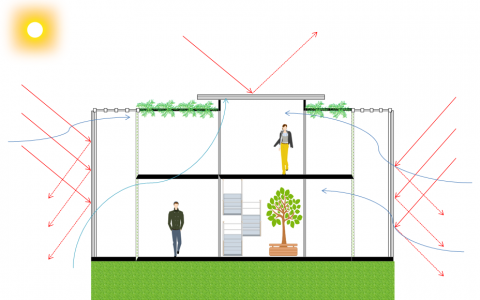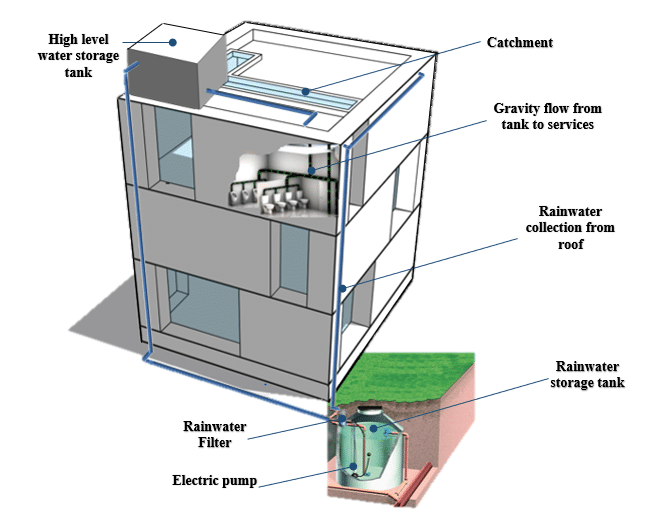Energy efficiency of buildings, Nairobi
About Nairobi
Nairobi is the capital of Kenya. This city is the 10th largest city in Africa, and the economical and political center of the country. Nairobi is cataloged as a lower-middle-income city, with sensitivity and exposure “very high” to climate change (Leal Filho et al, 2019).
In Nairobi, the summer is short, hot and cloudy while winter is short, fresh, dry and partly cloudy. During the course of the year, the temperature generally varies from 12°C to 27°C and rarely falls below 10°C or rises above 29°C. Climate change and rising temperatures have a bigger effect in the slums of Nairobi, where the average temperature is from 2.8 to 5.6°C higher than the rest of the city (Scott et al, 2017).
Kenya has a current effective installed electricity capacity of 1,429 MW, composed of 52.1% from hydropower, 32.5% from fossil fuels, 13.2% from geothermal and the remaining by biogas and wind. For lightning, only 42% of households use electricity the 55% remaining are still using kerosene lamps (Energypedia, 2019).
City Challenge
Nowadays, Nairobi has a lot of challenges, some of them are the insufficient and incomplete data on energy efficiency, a high level of informal settlements, lack of awareness of energy efficiency opportunities, especially in residential sector and in municipal buildings there is no sense of responsibility in saving resources, lack of supply of clean water and sanitary facilities.
According to Nairobi’s City representative, in Nairobi’s public buildings artificial heating is not necessary, but such buildings experience high running costs, especially electricity bills, due to gadget use, security lighting, running of lifts and pumping water to upper storage tanks. And, because of that, there is an opportunity for roof water harvesting which could be channeled to toilets within the complex that most times lack flushing water.
Solution
Several factors contribute to the high energy use, such as the use of older inefficient technologies, poor maintenance, split air-conditioning units into some offices, implications of climatic conditions not fully implemented in building designs, and limited awareness among staff about how to reduce wasteful consumption (Copenhagen Centre on Energy Efficiency, 2018).
Sustainable building design requires considerations about all three sustainability dimensions: environmental, economic and social. Because of the massive urban development ongoing in developing countries, to prevent an excessive increase in energy consumption and consequently greenhouse gas emissions, one of the main objectives for a designer is the reduction of building energy consumption (Aste, Adhikari, Del Pero, Leonforte, Timis, 2017).
Nowadays, the main concerns are related to the development of technologies that are inside sustainable development goals. However, not only is it necessary to create new technologies and applied them but also to clarify the importance of these, and change the community behavior to conserve natural resources. In that sense, the present solution consists of incorporate bioclimatic architecture to design or modify a building, taking advantage of the available resources, like sun, rain, wind, vegetation. This saves energy consumption and reduces environmental impact.
Solution 1: Bioclimatic Buildings.
For new buildings, that haven’t considered in the design an efficiency concept, we propose the solution of planing them as bioclimatic buildings. This concept (of bioclimatic constructions) refers to the design of buildings based on local climate, that aims to provide thermal and visual comfort to the occupants of the building (Center for Renewable Energy Sources and Saving, n.a.). There is a list of criteria to define a subjective term as “thermal comfort”. Dry bulb temperature, clothing level, air velocity, humidity, metabolic rate and mean radiant temperature are some variables in which thermal comfort it’s based (Daemei, Eghbali, & Khotbehsara, 2019), and helps to understand what is needed from each building according from initial conditions of these variables.
To evaluate a bioclimatic building from a conventional, it’s necessary to compare in terms of costs the performance of each edification in lighting, cooling, heating and operational costs. In Nairobi, the construction of buildings applying bioclimatic architecture would be a possibility considering that cost can be affordable and competitive for the city (Aste, Adhikari, Del Pero, Leonforte & Timis, 2017).
There are some aspects that must be considered when a bioclimatic building is designed, such as:
- Correct ventilation and insulation of the walls to achieve maximum efficiency in maintaining the temperature inside the building.
- Integrated renewables energies.
- The orientation of the construction, to take full advantage of daylight hours. It is important to take into account that solar radiation can be useful to provide natural light in buildings, reducing the need for artificial lighting. This can reduce energy use, and, therefore, CO2 emissions.
- Use of all the materials that can be natural or sustainable, and those that are mostly used in the region.
- The color of both the ceilings and the walls also has a big influence in these constructions, because the glades reflect the light and thus the spaces are cooled. The dark ones, on the other hand, for example in ceilings, absorb light and therefore heat.

An scheme of a bioclimatic building is shown in the picture. Here, some parts of the ceiling are made out of glass so that solar light can enter the building. Also, there a part that consists of a green ceiling, to help absorb the solar radiation so that it doesn’t enter the building. And the walls aren’t entirely solid, so that natural ventilation enters through the building.
Advantages.
- Constructive processes are cleaner than traditional processes.
- Reduction of using in HVAC systems, causes a reduction in maintenance costs.
- Energetic saving is the most important variable affected, even it’s possible to achieve energetic self-sufficiency (GreenDates, 2019), causing an important energy costs reduction associated to utilities.
- Increase of thermal comfort without the use of ventilation systems, or reducing it’s use to its slightest expression.
Disadvantages.
- There are many conditions that could affect the energetic performance of the building.
- In some climatic conditions, bioclimatic architecture could not be enough to satisfy thermal comfort and people may be forced to used ventilation systems.
- Some materials are difficult to find due to novelty.
- There is not enough staff (architects, builders) qualified in bioclimatic techniques (GreenDates, 2019), this may increase costs associated to professional fees.
Based on a case of study for a residential building in Nairobi, where all the necessary local climatic aspects are considered (Aste, 2017). The bioclimatic building design with 18% of energy saving will cost around 380 €/m2. Such value lies in the range of standard selling price of flats in Nairobi which ranging from 300 €/m2 to 490 €/m2 (Stima, 2019).
Solution 2: Rainwater Harvesting.
It doesn’t rain a lot in Kenya, however, it does happen twice a year in a few weeks of very heavy downpour (Rain Foundation, n.a.). In those weeks, an opportunity would be to collect that water and make use of it later to prevent drought. Particularly, in Nairobi, there are floods during rainy seasons but this water isn’t stored or treated, and in some seasons Nairobi City County faces water scarcity. The daily deficit in 2017, accounted for about 23% (Ombuna, 2017).
Rainwater harvesting consists of collecting water from surfaces on which rain falls, and storing it for later use. Roof-catchment rainwater harvesting systems consist of using the roof of a building as the water catchment area, and the gutters for collecting that water and carrying it to storage tanks (Ombuna, 2017). And this water can be used in the building, in non-drinking applications, such as in toilet tanks or to water plants.
According to Rainharvesting Systems Ltd. (2018), there are different rain harvesting systems, which are listed below:
- Water Butt
- Direct-Pumped (Submersible)
- Direct-Pumped (Suction)
- Indirect Gravity
- Indirect Pumped
- Gravity Only
According to Blue Mountain Co (2018), the 8 steps for rain harvesting are:
- Limit the sources of contamination
- Plan for volume
- Filter leaves and debris
- Divert the first flush
- Secure the system
- Manage standing water
- Consider a safety net
- Monitor and maintain

Advantages.
- Reduces water bills.
- Reduces demand of aqueduct water.
- Can be used in existing buildings.
- Reduces the risk of flooding (rainwater is collected in large storage tanks which can helps in reducing floods).
Disadvantages.
- Can be used in non drinking purposes only (for example: in bathrooms, to water plants).
- The amount of rainwater is unpredictable and the volume that can be stored is limited.
- The initial cost is high.
- The systems need maintenance to keep working efficiently.
“RWH Africa-interactive Tool”, is an effective tool option to gather the rain water information in concordance of the building’s occupance and geometry, and its appropriately storage, which takes into account the local climate conditions. Using the rainwater calculator of the Tool and some data of the building to intervene, it is possible to have an approximation of the total harvestable water from the roof, the storage capacity needed and the required rainwater harvesting system which includes the water storage capacity and the cost of water storage system, as show below.
| Item | Value | Units |
|---|---|---|
| Roof area | 200 | m2 |
| Paved Area | 200 | m2 |
| People that live in the building | 100 | – |
| Water consumption | 20 | Liters per person per day |
| Total harvestable water | 132.300 | L |
| Harvestable water from roof | 185.220 | L |
| Storage capacity needed | 2000 | L |
| Water storage capacity | 358.000 | L |

A scheme of a rainwater system (as we propose) is shown in the lateral picture. This is the proposed system, in which the water is collected from the gutters of the roof into pipelines that take it to a filter and then to a storage tank. Then, there is a pump that takes the filtered water to the toilet tanks through pipelines.
Legislative Framework, Proposed Regulations
Nowadays, there are some policies to aboard and stimulate the adaptation to new technologies, Green Africa Foundation created a certification or “GreenMark” in Kenya and East Africa and is a standard that provides guidelines for the independent assessment of the degree of ‘greenness’ of an existing or proposed building (Green Africa Foundation). For energy efficiency in buildings, they give a list of requirements based on energy monitoring, renewable energies for heating and cooking, optimization of energy performance. Besides, the Kenyan government released in 2018 the “National Climate Change Action Plan 2018-2022”, focused on changing energy sources and how it is used at residences, agriculture, industries, and commerce (Republic of Kenya, 2018).
However, many public policies have failed due to poor enforcement of policies, weak platforms to share information and inadequate capacitation of staff. Also, there’s no coordination between different government agencies (Leal Filho et al, 2019). On the other side, one of the elements of the challenge given to us is the lack of sense of environmental responsibility, difficulting the appliance of new politics to attack wastage of energy in buildings.
Local and national governments must support the initiative of the Green Africa Foundation because the benefits offered aren’t clear or sufficiently attractive to investors and builders. Policies should be oriented to give builders who use bioclimatic designs and more alternatives to increase energy efficiency in buildings, a reduction in rental incomes taxes by the order from 5% to 20%, according to a share from 20% to 40% of the habitational units built during a year.
Another strategy could be oriented to buyers of these houses, apartments, or other use of edifications (offices, shopping malls, municipal buildings) and obtaining a discount of 0.8% E.A period of 5 years in credit mortgage. This policy requires a conjunct collaboration between the financial sector, construction industry, and government to give and obtain a real impulse to the application of strategies to achieve energy efficiency in buildings. Organizations like Green Africa Foundation, from the government the Ministery of Environment and Forestry and the principal banks operating in Kenya (Standard Chartered, Barclays Kenya, National Bank, Equity Bank, Kenya Commercial Bank, etc) are responsible to evaluate and reinforce policies that conduct to the growth of energy-efficient buildings and create an attractive market to investors, buyers and builders. Also, non-profit associations like Kenya Rainwater Association (KRA), could help with the aim of rainwater harvesting in buildings, because this activity is congruent with the projects they have implemented and with the aim of the association. So, a partnership with this association would be helpful to achieve the implementation of rainwater harvesting systems.
A strategy to offset the unjustified expenditure of resources in municipal buildings is the education of people who use these resources. Among the important aspects of this, are: the discussion of notions, facilitators, obstacles and resource-saving strategies in these buildings, because even if there are energetically sustainable buildings, if the people who use them do not have the awareness to save the resource, the efforts to carry out the savings in the building could not be reflected.
Partnerships

References
Al-Masrani, S., Al-Obaidi, K., Zalin, N., & Aida Isma, M. (2018). Design optimization of solar shading systems for tropical office buildings: Challenges and future trends. Solar Energy, 170, 849-872. DOI: 10.1016/j.solener.2018.04.047
Aste, N., Adhikari, R. S., Del Pero, C., Leonforte, F., & Timis, I. (2017). Sustainable Building Design in Kenya. Energy Procedia, 105, 2803–2810.doi:10.1016/j.egypro.2017.03.606
Boemi, S, Irulegi, O & Santamouris, M. Energy performance of buildings: Energy Efficiency and Built Environment in Temperate Climate. Springer: Greece.
Center for Renewable Energy Sources and Saving. (n.a.). Bioclimatic Design and Passive Solar Systems. Available at: http://www.cres.gr/kape/energeia_politis/energeia_politis_bioclimatic_eng.htm
Copenhagen Centre on Energy Efficiency. (2018). Energy efficiency in buildings. In Energy Efficiency in Buildings: Nairobi, Kenya. Available at: https://apo.org.au/sites/default/files/resource-files/2018/11/apo-nid204206-1185896.pdf
Daemei, A. B., Eghbali, S. R., & Khotbehsara, E. M. (2019). Bioclimatic design strategies: A guideline to enhance human thermal comfort in Cfa climate zones. Journal of Building Engineering, 25, 100758. https://doi.org/10.1016/j.jobe.2019.100758
Energypedia. (2019). Kenya Energy Situation. Available at https://energypedia.info/wiki/Kenya_Energy_Situation
European Solar Shading Database. (n.a.). Low Energy. Available at: https://www.es-so-database.com/index.php/knowledge/low-energy
Fighting deforestation through fuelwood management – Nature Kenya”, Naturekenya.org, 2019. [Online]. Available at: https://nature kenya.org/2017/07/10/fighting-deforestation-through-fuel-wood-management/.
Prowler, D. (2016). Sun Control And Shading Devices. Available at:https://www.wbdg.org/resources/sun-control-and-shading-devices
Scott, A. A., Misiani, H., Okoth, J., Jordan, A., Gohlke, J., Ouma, G., Waugh, D. W. (2017). Temperature and heat in informal settlements in Nairobi. PLOS ONE, 12(11), e0187300. https://doi.org/10.1371/journal.pone.0187300
Filho, W. L., Balogun, A.-L., Olayide, O. E., Azeiteiro, U. M., Ayal, D. Y., Muñoz, P. D. C., … Li, C. (2019). Assessing the impacts of climate change in cities and their adaptive capacity: Towards transformative approaches to climate change adaptation and poverty reduction in urban areas in a set of developing countries. Science of The Total Environment. DOI:10.1016/j.scitotenv.2019.07.227
Green Africa Foundation. (n.a). Green Africa Building Standards and Certification. Available at: http://www.greenafricafoundation.org/programs/GAF_building_standards.php
Republic of Kenya, Ministry of Environment and Forestry. (2018). National Climate Change Action Plan 2018-2022. Available at: http://www.lse.ac.uk/GranthamInstitute/wp-content/uploads/2018/10/8737_vol3.pdf
Team

Industrial engineering student, 10th semester at the Universidad Nacional de Colombia, campus Medellín. E-mail: [email protected] Phone: +57 3105961220

Mechanical engineering student, 8th semester at the Universidad Nacional de Colombia, campus Medellín. E-mail: [email protected] Phone: +57 320553676
